The price for fashion. - Child labor in cotton fields
child labor in the production of hybrid cotton seeds in India
child labor in the cotton fields of Egypt taz 25.10.2005: Happy harvest for Bayer profits report on child labor in the production of cotton seed for Bayer
child labor in the production of hybrid cotton seeds in India quality improvement and increased production in the Indian cotton industry, and thus the creation of new jobs in India - this apparently positive process was set at the start of production of hybrid cotton seeds in India in transition. Only apparently positive This development with regard to children employed in the production: in India, about 450,000 children work in these establishments. Hybrid seed produced by crossing two pure-bred, but of different cotton plants. The result of this crossing plants are hybrids, which are distinguished by their greater efficiency in comparison with natural cotton plants, as for example, more cotton fibers haben.Da these hybrids do not self-fertile, must be crossed each year anew plant. This crossing of the plants is a complicated and stupid activity that much time to complete: 90% of the total work involved depends on it. Most Time the children are so in the fields busy to remove the cover and petals and the anthers of cotton plants, and then to their own seeds of plants by foreign seeds ersetzen.Die children work in the cotton farm between 9 to 13 hours daily and are usually employed as debt slaves. Its merit is 18 rupees per day, equivalent to 0.42 euros. In addition to the crossing of the plants their work is to sow the seed and harvest. Since they have to work 7-8 months a year, they have no way to go to school. In fact, 60% of them only a few years have attended school, 30% were never even in school Ausbildung.Neben lack of education , the work also dramatic health effects: in the cotton plants are about 55% of all employed in India pesticides used (India is following the global trend: although the cotton production accounts for a total of only 3%, are there 20% of all pesticides used). These highly dangerous substances, the children take on, especially at the junction of the flowers, because they have to be very close to the plants. The toxins affect the nervous system of children, leading to symptoms such as headaches, disorientation or dizzy spells.
The role of transnational companies in seed production of responsibility for these conditions, would also have big corporations take over, which yields ultimately buy the farms: these companies in India can not settle its own production, as the Indian law prohibits large land holdings. Therefore they are dependent on cotton production in the small Indian farms. At these farms, they take no direct contact, but they are indirectly through intermediaries, so-called seed organizers, in conjunction with them. Control the large companies have won over the small farms, because they make them every year for crossing the required seeds are available, set the quality standards and inspection rates.

could What do the participating multinationals against child labor, the resulting dependence of the small production of the international companies but could be exploited also by companies in order to contribute to a reduction in child labor in Indian firms: If the company increased acceptance pay awards had to pay local producers the opportunity to higher wages for adult workers (0.62 € and 0.95 € for women for men) and on child labor verzichten.Außerdem could be secured by contracts that only such Cotton is purchased from producers who do not Children occupied.
What can consumers do? To the consumer is directed above all the Clean Clothes Campaign, which is committed to fair working conditions in the textile industry. On their website one can learn,
what to look for one do if one wants to buy fair trade clothes,
let that corporate clothing produced under unacceptable working conditions which respect
which companies to fair working conditions,
and shows how you can actively participate in the campaign.

child labor in the cotton fields of Egypt Each year over one million children aged between seven and twelve years for various Activities in the cotton fields of Egypt is committed. You can both harvest of cotton, as are also used in the Schädlingungbekämpfung. Cotton is grown in huge monocultures and therefore expresses vulnerable to pests. In the summer months, the children have to scan by hand, row by row, the cotton plant after a caterpillar, and the infected leaves entfernen.Die use of children is so popular because the shrubs are still small at this time, and adults in the would have to bend over all day. Nevertheless, the plants are still four times injection of the harvest, among other means, as most of the WHO werden.Man-hazardous assumes that each year approximately 28 000 deaths are caused by the cotton pickers from the use of pesticides. Children are vulnerable areas to a greater degree, because their bodies are breaking down harmful substances not yet fully formed and the recording is facilitated by their thin skin layers. Consequently, many suffer from chronic inflammation of the eye, kidney and liver problems or respiratory diseases.
This form of child labor is not free from violence - in the words of a ten year old boy: Our foreman is still relatively lenient with us ... If a child intentionally omits a perennial, it is beaten, but not when it accidentally mistake macht.Er orders stretch out his hands and strikes with his stick into it.
0 comments:
Post a Comment